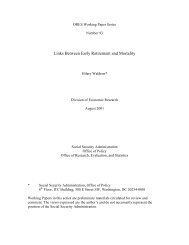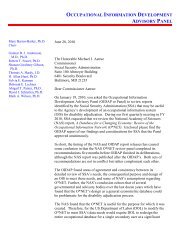average indexed monthly earnings (AIME). AIME isthen used in a formula to calculate monthly benefitamounts for OASDI beneficiaries. 44For individuals already receiving benefits, MEFrecords are used for several programmatic purposes.If a retiree has not reached his or her full retirementage and earns more than a specified amount in a year(in 2009, the amount is $14,160), benefits are reduced$1 for every $2 over the earnings limit (the reductionsare offset with an increase in benefits when the retireereaches full retirement age). 45 In addition, each yearSSA completes an Automatic Earnings ReappraisalOperation (AERO) or a manual recomputation todetermine if any new earnings have been posted to abeneficiary’s record. If so, the SSA computer systemrecalculates the monthly benefit (as described above).New earnings exceeding those in one of the previous35 highest years of earnings would change thebeneficiary’s AIME, resulting in higher benefits. Themaintenance of earnings information before and evenafter an individual begins receiving benefits is vital forthe operation of the program.In addition to program-specific uses, MEF dataare used to create other files of interest to researchers.One significant example is the Continuous WorkHistory Sample (CWHS). The CWHS is a 1-percentsample of all SSNs issued from 1937 to the currentyear. 46 It contains earnings and employment informationderived from the MEF, demographic informationderived from the Numident, and annual benefit dataderived from the Master Beneficiary Record. 47 TheMEF data for the CWHS are extracted annually inJanuary, approximately 13 months after the end of thetax year, and are generally available in the spring ofthat year, after the file is validated (for example, the2007 CWHS was pulled in January 2009 and will beavailable in mid-2009). The CWHS is broken into anactive file (3.3 million records were in the 2006 file),which includes SSNs with any earnings in the MEF;and an inactive file (1.1 million records were in the2006 file), which includes SSNs that have never hadearnings posted to the MEF. 48 The CWHS is used bySSA researchers as well as by those at the TreasuryDepartment and the Congressional Budget Officethrough Memoranda of Agreement (MOA). IRS lawprecludes its release to others (Buckler 1988).In addition to the 1-percent sample describedabove, the CWHS system produces two annualEmployee-Employer (EE-ER) files, a LongitudinalEmployee-Employer Data (LEED) file, and an annualSelf-Employment (SE) file, all of which are 1-percentsamples based on data contained in the MEF. Of thetwo EE-ER files, one contains covered wages only andthe other contains both covered and noncovered wages(this includes nontaxable wages and HI-only taxablewages and covered employment). The EE-ER filesalso contain age, sex, race, and deferred-compensationcontributions variables. The importance of these filesis that they show employee and employer location(county and state) and the employer’s type of industry,since wages are reported at the employer level in theDetail Segment of the MEF (Panis and others 2000). 49For each tax year, one version of the EE-ER is createdwhen the data for the active CWHS are extracted anda second is created 2 years later, to incorporate anydelinquent earnings data and to be added to the LEEDfile. The LEED file is a 1-percent longitudinal sampleof the EE-ER records with data for 1957–2004. 50 Theindustry data contained in the CWHS and EE-ER filescome from the IRS Form SS-4 Application for an EIN,income tax returns, and from the Census Bureau. 51These data are categorized according to the NorthAmerican Industry Classification System (NAICS),which assigns industry codes for the United States,Canada, and Mexico (Census Bureau 2009). TheLEED file is used for studies of workers in differentgeographic regions and different industries over time(Panis and others 2000). The SE file is an annual snapshotof initial self-employment postings to the MEF inthe most recent earnings-processing year and containsdata sent by IRS to SSA, which is not stored on theMEF but is useful for statistical and research purposes(such as geographic data, farm/nonfarm earningssplits, and use of optional reporting methods).MEF data are also used for certain statistical <strong>publication</strong>sand data files, such as Earnings and EmploymentData for Workers Covered by <strong>Social</strong> <strong>Security</strong>and Medicare, by State and County; Benefits andEarnings Public Use-File, 2004; and certain tablesin the Annual Statistical Supplement to the <strong>Social</strong><strong>Security</strong> Bulletin. 52 A new public-use earnings datafile based on a 1-percent random sample of workers iscurrently being developed in SSA’s Office of Retirementand Disability Policy (ORDP) for disseminationon the <strong>Social</strong> <strong>Security</strong> web site. This file could be veryuseful for outside researchers who are interested inlong-term U.S. earnings data. In addition, SSA haspublished many studies using MEF data. 53 As notedearlier, because the MEF contains tax return information,access is granted only according to terms of theInternal Revenue Code. The primary organizationsthat have been granted access to the MEF data for40 <strong>Social</strong> <strong>Security</strong> Bulletin • Vol. 69 • No. 3 • 2009
esearch purposes are the Census Bureau, the Departmentof Treasury, and the Congressional BudgetOffice. The University of Michigan obtained theconsent of respondents to use MEF data for its Healthand Retirement Study (HRS). Outside researchershave coauthored papers with SSA employees who haveaccess to the data, or used Census Bureau data linkedwith MEF data after being granted access by both theIRS and the Census Bureau. 54,55ConclusionIn 1938, John J. Corson, Director of the Bureau of Old-Age Insurance, noted “[a]s a byproduct of its necessaryoperations, the records of the Bureau of Old-AgeInsurance will in [the] future provide a wealth of newsources of information regarding the working populationof the United States.” The Master Earnings Filewas created for the purpose of calculating benefits, butas Corson predicted, it has been used more broadly forimproving the administration of the <strong>Social</strong> <strong>Security</strong>program. The earnings data available at SSA are usedby researchers, analysts, and others to understand thepast and present U.S. working populations. As withany large administrative data set, the MEF has somelimitations of which researchers should be aware.Nevertheless, it is the premier source of earnings dataon U.S. workers.NotesAcknowledgments: The authors thank Michael Compson,Susan Grad, Joyce Manchester, David Pattison,Carolyn Puckett, Dave Shoffner, Jae Song, Hilary Waldronand David Weaver for their helpful comments and suggestions.In addition, comments received from Phil Itzkowitzand his staff in the SSA Office of Systems and from BertKestenbaum, Jeff Kunkel, and Bill Piet in the SSA Office ofthe Chief Actuary were very useful.1IRS tax data are governed by section 6103 of theInternal Revenue Code. SSA can use it only to recordwages and cannot share it with any other federal agency.For more information, see http://www.irs.gov/govt/fslg/article/0,,id=158487,00.html. For general information on theMaster Earnings File, see the Privacy Act Notice at http://www.socialsecurity.gov/foia/bluebook/60-0059.htm.2Some earnings data derived from the MEF are availableonly to a restricted set of researchers, while other earningsdata are more widely available. For more information onaccess to the MEF, see the Uses of the Master Earnings FileData section of this article.3For the full text of the original <strong>Social</strong> <strong>Security</strong> Act of1935, see http://www.socialsecurity.gov/history/35actinx.html.4For information on how an employer withholds thesetaxes from an employee’s pay today, see IRS Publication 15,available at http://www.irs.gov/pub/irs-pdf/p15.pdf.5Other groups not covered by the original <strong>Social</strong> <strong>Security</strong>Act include agricultural workers, domestic servants,casual laborers, maritime workers, employees of federaland state governments or their instrumentalities, thoseworkers employed after reaching age 65, and employees ofreligious, educational, charitable, and nonprofit organizations(SSB 1938). For more information on the history ofcoverage, see Myers (1993).6The major groups that are not covered include civilianfederal employees hired before January 1, 1984; railroadworkers; certain employees of state and local governmentswho are covered under their employers’ retirement system;domestic workers and farm workers whose earnings do notmeet certain minimum requirements; and persons with verylow net earnings from self-employment.7The taxable maximum was set by statute for the years1937–1974 and 1979–1981 (SSA 2009a). Amounts for allother years were determined under the automatic adjustmentprovision of the <strong>Social</strong> <strong>Security</strong> Act, established in the1972 <strong>Social</strong> <strong>Security</strong> Amendments (for more informationon these amendments, see http://www.socialsecurity.gov/history/1972amend.html). For the full list of taxablemaximum changes, as well as <strong>Social</strong> <strong>Security</strong> and Medicaretax rates and the rates paid by the self-employed up to themaximum amounts, see SSA (2008), Table 2.A3, availableat http://www.socialsecurity.gov/policy/docs/statcomps/supplement/2008/2a1-2a7.pdf.8For more information on QCs, see http://www.socialsecurity.gov/OACT/COLA/QC.html.9Part C (Medicare Advantage) and Part D (PrescriptionDrug Plan) have since been added to the Medicare program.For more information on Medicare, see http://www.socialsecurity.gov/pubs/10043.pdf.10There are instances in the MEF when nongovernmentalworkers appear to have MQGE wages because theirreported Medicare taxable wages are greater than their<strong>Social</strong> <strong>Security</strong> wages and the latter is less than the OASDItaxable maximum. These appear to be reporting errors,but are stored on the MEF as if they are Medicare wages inexcess of <strong>Social</strong> <strong>Security</strong> wages.11For more information on these federal governmentemployees, see http://www.socialsecurity.gov/retire2/fedgovees.htm and for more information on state and localgovernment employees, see http://www.socialsecurity.gov/slge/.12Because <strong>Social</strong> <strong>Security</strong> benefits are based on anindividual’s earnings record, self-employed workers receiveless credit for earnings in 1990 and later because of the factorapplied to adjust their IRS net earnings by the amountsof OASDI and Medicare payroll taxes due.<strong>Social</strong> <strong>Security</strong> Bulletin • Vol. 69 • No. 3 • 2009 41
- Page 1 and 2: Social SecuritySocial SecurityBulle
- Page 3: Social SecurityBulletin Vol. 69, No
- Page 6 and 7: Perspectives77 An Empirical Study o
- Page 8 and 9: Selected Abbreviations—continuedM
- Page 10: within the next few years (Aglira 2
- Page 14 and 15: coverage varies significantly by ra
- Page 16 and 17: non-Hispanic white, and college edu
- Page 18 and 19: same groups (Table 6). For the last
- Page 20 and 21: from DB to DC pensions is accelerat
- Page 22 and 23: Table 8.Percent of individuals who
- Page 24 and 25: not necessarily the largest gains a
- Page 26 and 27: shoring-up DB plans before those pl
- Page 28 and 29: Table B-1.Percent change in mean pe
- Page 30 and 31: Table B-3.Percent of individuals wh
- Page 32 and 33: ReferencesAaronson, Stephanie, and
- Page 35 and 36: Social Security Administration’s
- Page 37: Chart 1.Historical expansion of Soc
- Page 40 and 41: self-employment information for the
- Page 42 and 43: (Cronin 1985). The final earnings r
- Page 44 and 45: prior to 1950, first year of earnin
- Page 48 and 49: 13For an explanation of how the sel
- Page 50 and 51: Kopczuk, Emmanuel Saez, and Jae Son
- Page 53 and 54: Occupations of SSI Recipients Who W
- Page 55 and 56: on the differences between the occu
- Page 57 and 58: prediction models. Table A-1 lists
- Page 59 and 60: Occupational Distributions of theEm
- Page 61 and 62: similar, only 4 percent of the popu
- Page 63 and 64: Table 5.Estimated occupational dist
- Page 65 and 66: Table 7.Predicted Herfindahl-Hirsch
- Page 67 and 68: Table 9.Estimated occupational dist
- Page 69 and 70: Table 11.Average annual wages of wo
- Page 71 and 72: Table A-2.Means and standard errors
- Page 73 and 74: Table A-3.Coefficients and standard
- Page 75 and 76: Table A-3.Coefficients and standard
- Page 77 and 78: Table A-3.Coefficients and standard
- Page 79 and 80: management, professional, and relat
- Page 81: Stapleton, David C., Nanette Goodma
- Page 84 and 85: Selected Abbreviations—continuedO
- Page 86 and 87: The 1983 Amendments to the Social S
- Page 88 and 89: Chart 1.Proportion of new claimants
- Page 90 and 91: Table 4.The evolution of the ARF an
- Page 92 and 93: for the test of equality of means b
- Page 94 and 95: Table 8.Average monthly Social Secu
- Page 96 and 97:
in the chart, especially for men, t
- Page 98 and 99:
6This is a very important character
- Page 100 and 101:
Benítez-Silva, Hugo, Berna Demiral
- Page 103 and 104:
OASDI and SSI Snapshot andSSI Month
- Page 105 and 106:
Monthly Statistical Snapshot, Augus
- Page 107 and 108:
Table 2.Recipients, by eligibility
- Page 109 and 110:
SSI Federally Administered Payments
- Page 111 and 112:
Table 7.Average monthly payment, by
- Page 113:
Awards of SSI Federally Administere
- Page 116 and 117:
Copyright—Authors are responsible
- Page 119 and 120:
Program Highlights, 2009Old-Age, Su








